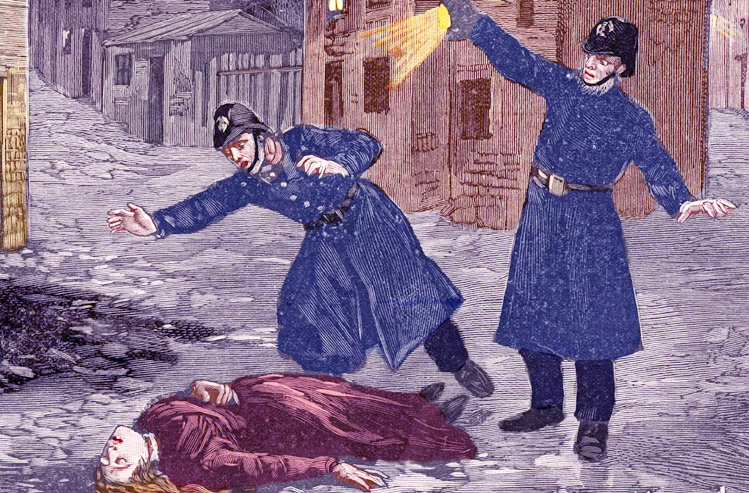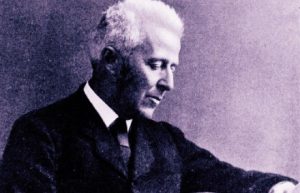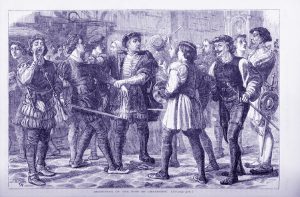
One of the most fascinating cases in the history of crime is the unsolved murders of Jack the Ripper. The “Ripper” has featured in many movies and television series, in serial novels and literature. His identity has changed dozens of times, as has the reason for the murders. He has been confronted by Sherlock Holmes, kicked off a bridge in Shanghai Knights, and is a major character in a Syfy series. Though he always faces discovery and capture on film, the audience is left knowing they never found the real Jack the Ripper… or if they did, they never told the public.
During the 1880s in Whitechapel, five prostitutes were brutally killed and certain of their organs removed. While eventually the killings stopped, there was no official “closing” of the case. Speculation of what happened and whether the police ever solved it has enraptured crime enthusiasts ever since. One of my favorite theories is Dr. Joseph Bell, the mentor of Arthur Conan Doyle, and the inspiration for Sherlock Holmes, solved it. Bell was a forensic expert, and it’s possible many of Doyle’s stories were based on actual crimes handled by Dr. Bell. The pilot for the BBC series Murder Rooms pits Bell against the Ripper when he comes to Edinburgh and explains why he never got caught. While the story is only “loosely” based on the Ripper murders, it involves an actual and lesser-known suspect linked to the Ripper case.
There are several prevalent theories, but the one that emerges as the most commonly used in films and novels is the murders were not the work of a madman choosing victims at random, but intended to conceal the true victim. One popular suspect is Queen Victoria’s son Albert, known as “Eddie” to his friends. The story is Eddie fell in love with and secretly married a Catholic girl, who bore him a child. When the royal family discovered this, they institutionalized the woman and her friends in the female working class were murdered to learn the whereabouts of her child. The most popular film that supports this theory is From Hell, starring Johnny Depp and Heather Graham, but it also features in Murder by Decree, in which Sherlock Holmes unearths the truth, and with Michael Caine in the television movie Jack the Ripper. This theory is so popular it is difficult to find a film that does not go that route.
While intriguing for its political ramifications and scandalous in its suggestion that the royal family sanctioned murder to cover up an unwanted heir, the association between Eddie and Jack the Ripper is not widely accepted among Ripperologists (it is unsubstantiated and too unbelievable to be a valid theory), leaving several other suspects. Hundreds of individuals have been named as suspects, from children’s author Lewis Carroll (Alice in Wonderland) to the possibility that Jack the Ripper might have been a woman. The chief detective on the case posed this theory when witness statements contradicted Mary Kelly’s time of death, indicating the murderer might have left her room wearing her clothes. Some dismiss this as unlikely, but there are others who believe it is possible: the police were searching for a man, which meant a woman could go relatively unnoticed. Public concern toward violence might have made prostitutes less likely to trust men, where they would be open to walking with a woman. The medical knowledge implied in the murders might have belonged to a physician, midwife, or abortionist. Some even believe Mary Kelly was pregnant at the time of her death and summoned an abortionist on the night she died.

When asked his opinion by the press, crime author Sir Arthur Conan Doyle stated he suspected the Ripper was a man dressed as a woman to earn the trust of his victims. In almost all the films, the primary detective (frequently Inspector Abberline) develops an unusual theory which he cannot prove, while becoming close to the future victims. Mary Kelly is usually the leading lady, since she was the last girl to get killed, leading to a dramatic rush to save her life. Often, she is the only one who “knows the truth” and is silenced. One or two films suggest she survives, and another girl is murdered in her place in a case of mistaken identity. In order to make her more empathetic, Mary’s profession is downplayed or excused in people mistaking her for a prostitute, and there is a romantic attraction between her and the investigator.
Another common character is Robert Lees, a Victorian Spiritualist who experienced troubling “visions” of Jack the Ripper during the murders. One of the Ripper’s letters to the police claiming responsibility for the crime and taunting their inability to solve it mentions Lees by name. In From Hell, Lees’ visions are given to Abberline, while in Murder by Decree, he is vital to the plot.
Then there’s the sci-fi series Sanctuary, in which it is revealed a group of Victorian scientists’ experimentation with vampire blood led to different supernatural abilities: Helen Magus has the gift of longevity, John Watson increased his mental abilities, Nikola Tesla became a vampire, Nigel Griffin has powers of invisibility, and John Druitt became a time-traveler. But Druitt’s newfound abilities combined with his lingering psychosis sent him on a brutal murdering spree in Whitechapel. He appears over a hundred years later, and seeks to reconcile with Helen and their daughter, Ashley, who has inherited certain of his “gifts.”
While a sad and morbid tale, it is fascinating to contemplate the details of the Ripper case, and to be relieved that whoever was responsible got held accountable, if not in this world, then the next.
Want more fiction set in the shadowy streets of Ripper-era Britain? Meet Dr. Joseph Bell and a girl with a soul-stealing gift in my novel The Giftsnatcher.





